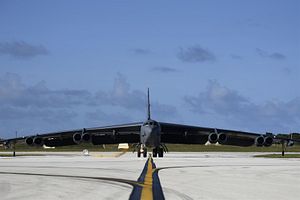Two U.S. Air Force (USAF) B-52H Stratofortress strategic bombers flew a patrol over the East and South China Seas on March 4, to according to U.S. Pacific Air Forces.
The mission was first reported by ABC News.
“Two B-52H Stratofortress bombers took off from Andersen Air Force Base, Guam, and participated in routine training missions, March 4, 2019,” according to a statement from U.S. Pacific Air Forces. “One bomber conducted training in the vicinity of the South China Sea before returning to Guam, while the other conducted training in the vicinity of Japan in coordination with the U.S. Navy and alongside our Japanese air force counterparts before returning to Guam.”
Both bombers were refueled mid-air by a Boeing KC-135 Stratotanker.
Pacific Air Forces conducts such long-range patrols on a regular basis in support of U.S. Indo-Pacific Command’s continuous bomber presence mission in the Indo-Pacific region. The two B-52H strategic bombers are part of a USAF contingent currently forward-deployed to Andersen Air Force Base on Guam in the Western Pacific. USAF B-52H bomber units have been deploying to Guam on a rotational basis since January 2018 after a 17-month interval. As I explained previously:
The service redeployed the B-52H to Guam as part of the U.S. Indo-Pacific Command’s continuous bomber presence mission in the Asia-Pacific region in January. B-52Hs last deployed to Guam in July 2016. The B-52Hs took over responsibility from the B-1B Lancer heavy strategic bombers of the USAF’s 9th Expeditionary Bomb Squadron (EBS) of the 7th Bomb Wing, which deployed to the region in February 2017.
U.S. Air Force B-52Hs have conducted patrols over the East and South China Seas in recent months. B-52Hs last transited the East and South China Seas in September and November 2018 respectively. B-52Hs and U.S. Navy P-8A Poseidon maritime patrol aircraft also flew a training exercise in near Japan over the East China Sea in August 2018.
As I noted in January, the USAF currently operates 58 B-52H long-range, heavy strategic bombers. The B-52H is capable of flying at high subsonic speeds at altitudes of up to 50,000 feet (15,166.6 meters) and can either carry nuclear-tipped cruise missiles or a conventional payload of up to 70,000 pounds (31,500 kilograms). Under the 2010 New Strategic Arms Reduction Treaty (START), 41 B-52Hs had to be denuclearized.
“The denuclearized variant of the B-52H carries JASSM [AGM-158B Joint Air-to-Surface Standoff Missile] and JASSM-ER [Extended-Range] long-range, radar-evading cruise missiles, whereas nuclear-capable bombers carry the nuclear-tipped AGM-86 air-launched cruise missile,” I explained elsewhere.
U.S. Pacific Air Forces does not publicly comment on whether the bombers deployed during recent missions are nuclear-capable. “We do not discuss the nuclear capabilities of our operational bomber aircraft to that level of specificity for security reasons,” a Pacific Air Forces spokesperson said in a January 30 email to The Diplomat.






























